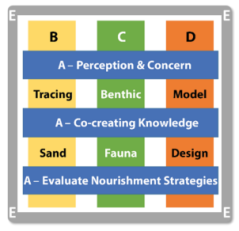
Project
TRAILS: TRacking Ameland Inlet Living Lab Sediment
Goals and aims
Sand nourishment is now the preferred coastal management strategy in the Netherlands to prevent coastal erosion and drowning of intertidal areas of the Wadden Sea. Nourishments aim to enhance safety, while simultaneously promoting natural and recreational values. However, it is poorly understood how nourished sand is dispersed, and what the impacts are for diverse coastal functions like biodiversity, fisheries and safety. In this project, Ameland Inlet is our Living Laboratory to develop and test methods to determine the fate of nourishment sand, and to work with stakeholders to clarify impacts and co-assess nourishment strategies.

The location of the ebb-tidal delta nourishment within our Living Laboratory, with possible sediment transport pathways indicated
The overall aim of this project is to develop, test and apply the instrumentation that is needed to predict effectiveness and off-site responses to (mega-)nourishments. Main objectives of the project are:
- To create a fully operational Living Lab with all stakeholders to co-evaluate future nourishment strategies, based on a shared knowledge base.
- To develop and test novel luminescence-based methods to identify sand grains derived from a nourishment source and illuminate sediment pathways.
- To determine the effects of nourishments on benthic fauna, and identify and quantify the feedback mechanisms of the benthic community on sediment dispersal.
- To develop and test novel simulation approaches to trace pathways of different sediment types and predict sediment dispersal and morphodynamic responses to different nourishment strategies.
- To integrate insights gained from stakeholder, field and model approaches.
Work package A
The importance of sand nourishments for our coastal defense is undisputed. However, many local stakeholders are concerned about potential detrimental effects of nourishments on the ecological system and economic functions. In our project, we will address this issue using an integral stakeholder approach, based on a dialogue between local stakeholders, researchers and coastal managers. The Living Laboratory of Ameland Inlet provides us with the opportunity to enhance existing dialogues between these groups and initiate new ones. Towards this end, we will gather, merge and process information from all stakeholders using online tools and interviews, and we will organize meetings of the full consortium and local stakeholders each year.
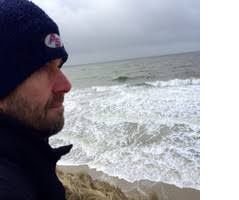
Scientist in the picture: David Goldsborough is leading work package A and is a senior lecturer/ researcher on Marine Policy at Van Hall Larenstein (VHL), University of Applied Sciences in Leeuwarden, the Netherlands. He is an environmental scientist by training. His key research interest is on the science-policy-practice interface in marine conservation with emphasis on documenting and understanding marine governance.
Work package B
Work package B focusses on developing luminescence techniques as a novel sediment tracing tool. Luminescence is a well-established method in dating the time of deposition and burial of sand grains. Insufficient luminescence signal resetting (e.g. poor bleaching) resulting in age overestimation is unwished-for in dating sediments. However, it is the main principle of the tracing mechanism: the native beach sediment is expected to be well-bleached in comparison to the poorer bleached nourished sand. Upon transport the nourished sands will be partly light exposed, where the intensity of bleaching strongly depends on the luminescence signal, e.g. fast-to-bleach quartz-OSL or slow-to-bleach TL and/ or (pIR)IR-feldspar signals. We hypothesize that the differential resetting of luminescence signals can give us insight into the end-member (native or nourished sand) and its transport history.
The objectives of this work package are:
- Develop a suitable luminescence measurement protocol for differentiating nourished sand grains from native Wadden Sea sand grains based on single-grain feldspar measurements.
- Quantify how the subaqueous spectral distribution in the Ameland Inlet changes over depth as a function of climatological and hydrological conditions. Couple the spectroscopic variations to subaqueous bleaching potential of the slow- and fast-to-bleach luminescence signals.
- Quantify bleaching of native and nourished sands, in close collaboration with Stuart Pearson and Natascia Pannozzo (TU Delft). Trace the spatial dispersion of nourished sands throughout the Ameland Inlet.
- Quantify the role of soil bioturbation on tidal flats in the Wadden Sea, in close collaboration with Tjitske Kooistra (NIOZ). Trace the mixing of nourished and native sands into the soil column.
See also: https://www.wur.nl/en/project/Luminescence-as-a-sediment-tracing-tool.htm
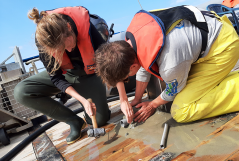
Scientist in the picture: Anna-Maartje de Boer (left) is a PhD Candidate at Wageningen University & Research (WUR) and a trained physical geographer with a main interest in the development and application of geochronological tools like luminescence techniques. Anna-Maartje is supervised and supported by Jakob Wallinga, who is a professor and luminescence specialist at WUR.
Contact details: anna-maartje.deboer@wur.nl, linkedin.com/in/annamaartjedeboer/, www.wur.nl/en/Persons/Anna-Maartje-AM-Anna-Maartje-de-Boer-MSc.htm

Conceptual overview of sediment tracing principle: the green nourished sand grain is transported away from the nourishment location on the left side of the image. Upon transport its various luminescence signals get bleached as indicated by the emptying of the hare (fast-to-bleach signal) and turtle (slow-to-bleach signals) batteries. The batteries of the native sand grains are emptied better than the ones of the nourished sand grains, since the native grains experienced more bleaching opportunities throughout time.
Work package C
Seafloor animals, so-called benthos, like razor clams and cockles have a strong relationship with their environment: their habitat is determined by the sediment type, and vice versa, they can also influence the stability and composition of the sediment themselves. The large amounts of sand that we use to protect our coasts, have a potential influence on the life of these animals. At the nourishment location animals that live on or just below the seafloor may suddenly be buried deeper or may no longer be able to filter the water for food. The Ameland ebb-tidal delta nourishment is placed directly at the entrance of the Wadden Sea, but we do not know exactly how it impacts the benthic communities and habitats in the hinterland, or whether the animals might even influence transport and composition of the sediment themselves.
In my research, I study the two-way traffic between sediment and benthic fauna. I use field data of benthos in the Wadden Sea, and perform field and lab experiments with bivalves such as razor clams (Ensis leii), cockles (Cerastoderma edule) and Baltic tellins (Limecola balthica) and worms such as the lugworm (Arenicola marina).
The first part of PhD focusses on how nourishments could affect the communities in the Wadden Sea. I use benthos distribution data from inter- and subtidal areas over multiple years and seasons to determine community variability and sensitivity to disturbance. To test impacts of a change in sediment composition, I perform field experiments on the mudflats.
In the second part, I use flume and mesocosm experiments to investigate how seafloor animals and their shells can influence sediment transport and composition. Shells structure the seafloor and reduce sand ripple formation, and by bioturbation animals can bury and resuspend particles. Both processes may influence the sediment distribution and change the benthic habitat.

Scientist in the picture: Tjitske Kooistra (left) is a PhD Candidate at the Netherlands Institute for Sea Research (NIOZ) and a trained ecologist. Tjitske is supervised and supported by Rob Witbaard, a Marine Ecologist from NIOZ. Contact details e-mail: tjitske.kooistra@nioz.nl, LinkedIn: linkedin.com/in/tjitske-kooistra2, Twitter: @tj_kooistra
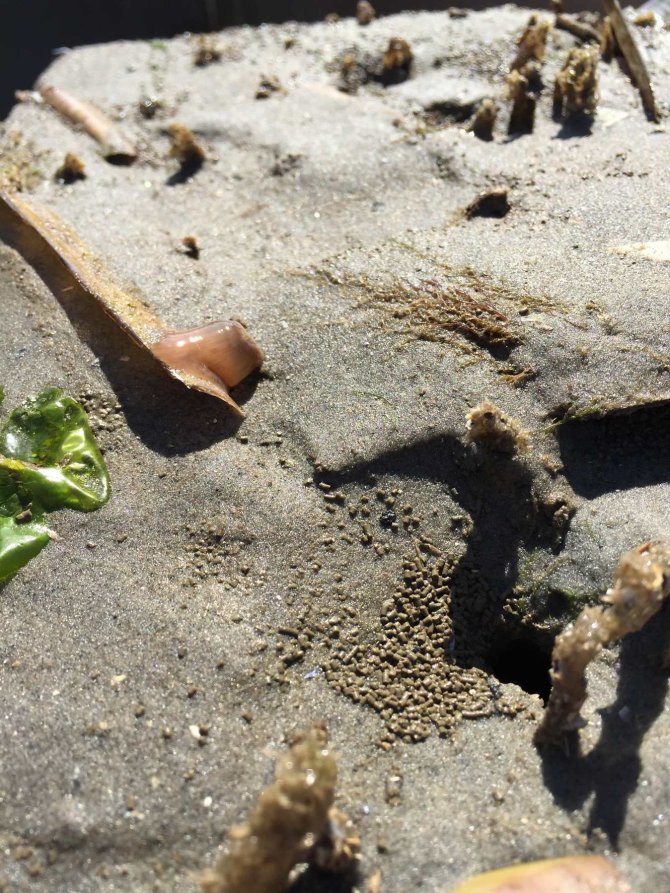
The top of a sediment core giving a view of the benthic community, consisting of, amongst others, sand mason worms (Lanice conchilega) and Atlantic razor clam (Ensis leei). The empty shells provide a substrate for hard-bottom species such as this anemone
Work package D
Where does the sediment from a nourishment go after it is placed? We can estimate the pathways that sediment takes by using computer simulations that approximate the physics of waves, currents, and sediment transport. Sediment transport can be analysed from the perspective of moving grains (Lagrangian viewpoint) or by looking at morphodynamic changes (Eulerian viewpoint), and each approach is suited for different purposes. Here we apply both approaches with the goal of improving existing sediment transport models and optimizing sand nourishment strategies.
RQ D1: How to improve sediment transport models to better understand sediment pathways?
We will further develop the SedTRAILS (Sediment TRAnsport vIsualization & Lagrangian Simulator) model to improve its ability to estimate coastal sediment pathways.
RQ D2: What pathways do individual grains of nourished sand take as they disperse along the coast?
SedTRAILS will be applied to the case of the Ameland ebb-tidal delta nourishment, relying closely on the work Anna-Maartje de Boer (Work Package B) to validate the model.
RQ D3: How do nourishments affect the morphodynamic evolution of the surrounding area?
To fully understand the dispersal of nourishments and subsequent impacts, the morphodynamic evolution will be simulated using Delft3D/DFlow-FM models. We will also collaborate with Tjitske Kooistra (Work Package C) to estimate the potential interaction of nourished sediment with benthic ecosystems.
RQ D4: How can process-based numerical models be used to design more effective nourishments?
Together, the results of both the particle tracking and morphodynamic modelling are used to test hypotheses of sediment dispersal. For instance, sediment transport from nourishments to sensitive ecological habitats can be assessed. Furthermore, the numerical model provides a “Virtual Lab” to complement the “Living Lab”, enabling multiple nourishment designs and scenarios to be assessed together with stakeholders (WP A). From these experiments, a set of more general guidelines or techniques for effective nourishments are derived. Additionally, the particle tracking module provides visualizations of the sediment for easy engagement and interaction with stakeholders (WP A).
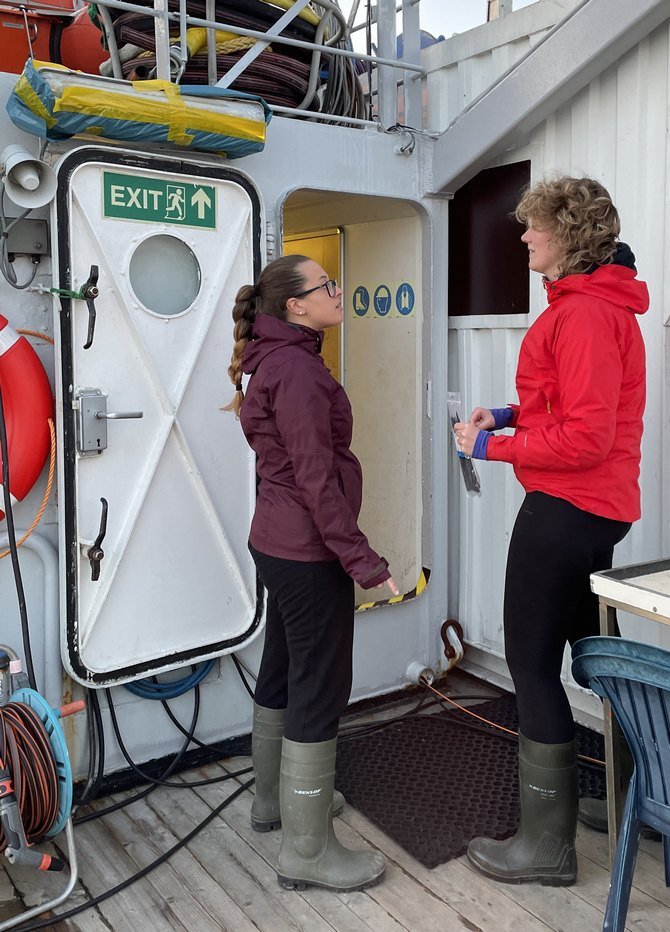
Natascia Pannozzo (left) is undertaking Work Package D as a postdoctoral researcher after carrying out her PhD at the University of Liverpool (2019-2023) investigating sediment transport dynamics in intertidal areas using a combination of field measurements and numerical modelling. Natascia is supported by Bram van Prooijen (Associated Professor at Delft University of Technology, specialised in hydrodynamics, fine sediment transport and geomorphology of estuaries, tidal basins, and coastal seas) and Stuart Pearson (Assistant Professor at Delft University of Technology and former postdoc of the project, specialised in sediment pathway and connectivity in coastal settings). Contact details: Email: N.Pannozzo@tudelft.nl; LinkedIn: https://www.linkedin.com/in/natascia-pannozzo-770969174/; Twitter: @NatasciaPannozz; TU Delft webpage.
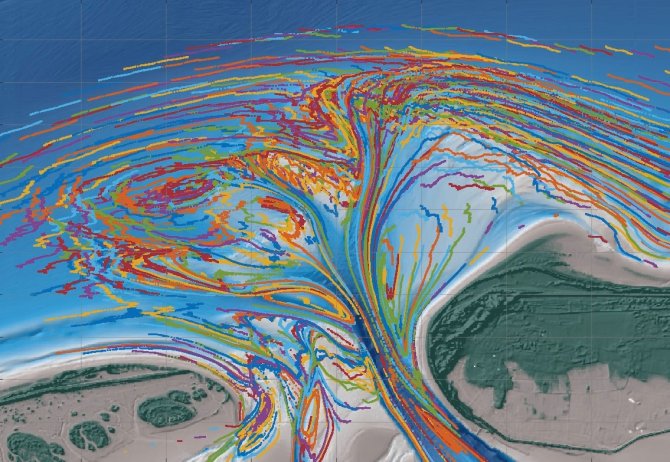
Sediment transport pathways on Ameland ebb-tidal delta computed using the SedTRAILS model. We will try to make sense of this “spaghetti” and use our tools to extend and communicate the findings of the other Work Packages
Work package E
Sand nourishments are a successful way to compensate coastal sand losses in the Netherlands. Applied annually since 1990, they have been able to reduce coastal erosion to about a third of previous values. Starting from little experience and learning by doing, nourishment designs have been growing from beach replenishments of a couple of hundred thousand cubic meters, to shoreface nourishments of one to several million cubic meters and beyond. Today, sand nourishments are used in pilot projects to force migrating tidal channels away from the coast, to beef up sand fluxes bypassing tidal inlets to feed adjacent islands and to create temporary peninsulas to feed coastal cells and, meanwhile, enlarge the surface area of beach, thus increasing recreational use and nature values. All are specific nourishment designs to restore or enlarge sand fluxes, concurrently addressing additional goals. These are called ‘system nourishments’.
Despite the above advantages for coastal maintenance and an increasing number of additional goals, the extraction and dumping of large volumes of sand raises concern. Impacts on seabed flora and fauna, both short-term and long-term, risk of covering valuable habitat with sediment or potential changes in coastal currents and waves that may affect swimmer safety and shipping, are side effects that need further study.
The TRAILS project aims to develop, test and apply the tools that are needed to predict the effectiveness and off-site responses to (mega-)nourishments. Studying sediment dispersal, both modelled and observed in the field, sediment composition changes and effects on benthic fauna caused by a large-scale sand nourishment and integration of the results of the individual work packages, offers the opportunity to obtain a more holistic understanding of the pros and cons of large-scale sand nourishment that will support the design and (co-)evaluation of nourishment strategies. This is the specific goal of work package E.
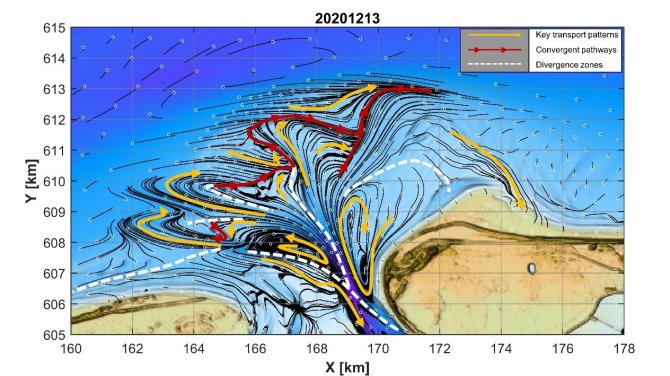
Schematised SedTRAILS particle-tracking results for a coupled tide and wave simulation performed using the 13/12/2020 bathymetry of Ameland Inlet which includes the pilot nourishment in the ebb-tidal delta. Source locations are indicated with a white circle and particle trajectories with a thin black line. Key transport patterns are illustrated with the yellow arrows, trajectories where the particles converge are shown in red and zones where the particle behaviour diverges are shown with dashed white lines.
TRAILS is funded by the Dutch Research Council (NWO), Domain Applied and Engineering Sciences
